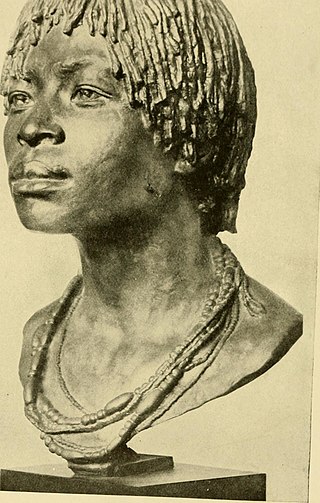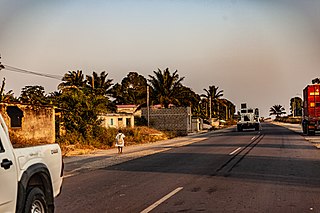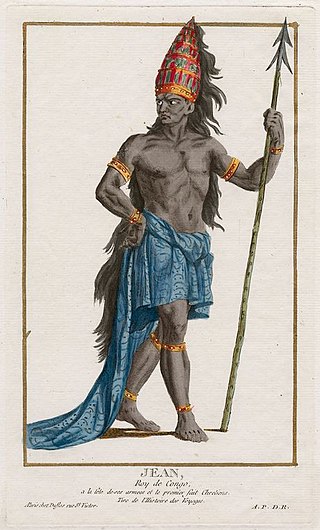Related Research Articles
The history of the Republic of the Congo has been marked by diverse civilisations: Indigenous, French and post-independence.

The Kongo people are a Bantu ethnic group primarily defined as the speakers of Kikongo. Subgroups include the Beembe, Bwende, Vili, Sundi, Yombe, Dondo, Lari, and others.

The Kingdom of Ndongo was an early-modern African state located in the highlands between the Lukala and Kwanza Rivers, in what is now Angola.

The Kingdom of Loango was a pre-colonial African state, during approximately the 16th to 19th centuries in what is now the western part of the Republic of the Congo, Southern Gabon and Cabinda. Situated to the north of the more powerful Kingdom of Kongo, at its height in the 17th century Loango influence extended from Cape St Catherine in the north to almost the mouth of the Congo River.

The Kingdom of Kongo was a kingdom in Central Africa. It was located in present-day northern Angola, the western portion of the Democratic Republic of the Congo, southern Gabon and the Republic of the Congo. At its greatest extent it reached from the Atlantic Ocean in the west to the Kwango River in the east, and from the Congo River in the north to the Kwanza River in the south. The kingdom consisted of several core provinces ruled by the Manikongo, the Portuguese version of the Kongo title Mwene Kongo, meaning "lord or ruler of the Kongo kingdom", but its sphere of influence extended to neighbouring kingdoms, such as Ngoyo, Kakongo, Loango, Ndongo, and Matamba, the latter two located in what is Angola today.

Soyo is a city, with a population of 200,920, and a municipality, with a population of 227,175, located in the province of Zaire in Angola, at the mouth of the Congo River. Historically, Soyo was a significant city in conflicts between the Kingdom of Kongo, Portuguese Angola, and the Dutch West India Company. Soyo became an independent state in the 17th century and had significant influence on politics in Kongo during the Kongo Civil War.
The Kingdom of Matamba (pre-1550–1744) was an African state located in what is now the Baixa de Cassange region of Malanje Province of modern-day Angola. Joined to the Kingdom of Ndongo by Queen Nzinga in 1631, the state had many male and female rulers. It was a powerful kingdom that long resisted Portuguese colonisation attempts, but was integrated into Portuguese Angola in the late nineteenth century.

Garcia II Nkanga a Lukeni a Nzenze a Ntumba, also known as Garcia Afonso for short, ruled the Kingdom of Kongo from 23 January 1641 to 1661. He is sometimes considered Kongo's greatest king for his religious piety and his near expulsion of the Portuguese from Angola. Yet, he is also notorious for enriching himself through his leading role in the Atlantic slave trade.

The Catholic Church arrived in the Kingdom of Kongo shortly after the first Portuguese explorers reached its shores in 1483. The Portuguese left several of their own number and kidnapped a group of Kongo including at least one nobleman, Kala ka Mfusu, taking them to Portugal where they stayed a year, learned Portuguese and were converted to Christianity. The group was returned to Kongo in 1485 and Kala ka Mfusu led a royal mission from Kongo's manikongo, Nzinga a Nkuwu to Portugal. Following their arrival in late 1486 the embassy stayed nearly four years in Lisbon with the monks of Saint John the Baptist. There they studied Christianity and Portuguese with Vicente dos Anjos, and began the start of a Kongolese version of Christianity.
Nsundi was a province of the old Kingdom of Kongo. Its capital was located on the Inkisi River, near the present-day village of Mbanza Nsundi in Democratic Republic of Congo.

The Kinlaza were members of the Nlaza kanda or House of Kinlaza, one of the ruling houses of the Kingdom of Kongo during the 17th century. It was one of the main factions during the Kongo Civil War along with the Kimpanzu and Kinkanga a Mvika kandas. They are remembered in tradition and are evoked in a proverb, still current in the 1920s Nkutama a mvila za makanda "Kinkanga, Kimpanzu ye Kinlaza makukwa matatu malambila Kongo".

Mvemba a Nzinga, Nzinga Mbemba, Funsu Nzinga Mvemba or Dom Alfonso, also known as King Afonso I, was the sixth ruler of the Kingdom of Kongo from the Lukeni kanda dynasty and ruled in the first half of the 16th century. He reigned over the Kongo Empire from 1509 to late 1542 or 1543.

King João I was the 5th ManiKongo of the Kingdom of Kongo between 1470 and 1509. He voluntarily converted to Roman Catholicism. He was baptized on 3 May 1491 and took the Christian name of João. Soon after, ManiKongo Nzinga-a-Nkuwu João I abandoned the new faith for a number of reasons, one of them being the Roman Catholic Church's requirement of monogamy. Politically, he could not afford to abandon polygamy and embrace monogamy, a cultural shift that the king could not contemplate as power in Kongo was elective, rather than hereditary as in Europe; as Kongo culture followed a matrilineality structure, where the elder son of the king is not automatically the next king.
The Kongo Civil War (1665–1709) was a war of succession between rival houses of the Kingdom of Kongo. The war waged throughout the middle of the 17th and 18th centuries pitting partisans of the House of Kinlaza against the House of Kimpanzu. Numerous other factions entered the fray claiming descent from one or both of the main parties such as the Água Rosada of Kibangu and the da Silva of Soyo. By the end of the war, Kongo's vaunted capital had been destroyed and many Bakongo were sold into the Trans-Atlantic Slave Trade.

Bernardo I of Kongo was a 16th-century manikongo (ruler) of the Kingdom of Kongo, a region encompassing areas in 21st-century Angola and the Democratic Republic of Congo. He came to power after murdering his half-brother Afonso II who was less well-disposed toward the Portuguese.
The Seven Kingdoms of Kongo dia Nlaza were a confederation of states in west Central Africa at least from the 13th century. They were absorbed into the Kingdom of Kongo in the 16th century, being mentioned in the titles of King Alvaro II in 1583. It neighboured the confederations of Vungu and Mpemba. Its capital district was on the Kwale River, and it controlled the lands eastwards to the Kwango River, northwards to the Pool Malebo, and westwards to the Inkisi River and north of the Kwilu River. This polity or region was first mentioned in texts of the Kingdom of Kongo in the late 16th century, although it probably existed much earlier. It was only then being incorporated into Kongo, through the kingdom's eastern province of Mbata. It is unclear what the Seven Kingdoms were, though perhaps they included Kundi and Okanga. Presumably these kingdoms represented an alliance of several smaller polities, though the sources of the time tell us nothing about it.

Mbanza Kongo, is the capital of Angola's northwestern Zaire Province with a population of 148,000 in 2014. Mbanza Kongo was the capital of the Kingdom of Kongo since its foundation before the arrival of the Portuguese in 1483 until the abolition of the kingdom in 1915, aside from a brief period of abandonment during civil wars in the 17th century. In 2017, Mbanza Kongo was declared a UNESCO World Heritage Site.

Pedro IV Nusamu a Mvemba. King of Kongo, ruled from 1695 to 1718, although his effective reign of Kongo was only from 1709. He is noted for restoring the country and ending the civil war that had raged since 1666. The career of Beatriz Kimpa Vita, the prophetess claimed to be possessed by Saint Anthony, took place during his reign.

Henrique was a Kongolese Catholic prelate, a prince of Kongo and a son of Afonso I. He became a Catholic priest shortly after the Christianization of the kingdom and dedicated his life to the catechism of the Kongolese, being appointed in 1518 titular bishop of Utica, in present-day Tunisia. He was the first Central African bishop in history.
References
- ↑ Pigafetta, Filippo (1881). A Report of the Kingdom of Congo and the Surrounding Countries. London: John Murray.p. 93
- ↑ Thornton, John (2020). A History of West Central Africa. Cambridge: Cambridge University Press. p. 68. ISBN 978-1-107-12715-9.
- ↑ Saccardo, Graziano (1982). Congo e Angola con la storia dell'antica missione dei Cappuccini. Venice: Curia Provinciale dei Cappuccini Venezia-Mestre. p. 56.